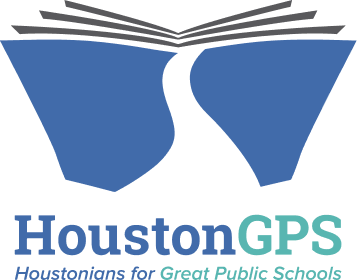Houston ISD Board Meeting Recap 5.9.24
The HISD Board held their May regular board meeting on May 9, 2024. Here’s a recap of the highlights.
Nearly a third of special education students are meeting above average growth targets by middle-of-year, with higher progress at NES campuses. As the district continues to prioritize special education as an intervention exit criteria, it must ensure it continues to maintain and accelerate growth.
The Board spent the majority of their work time focused on the NES curriculum, which provides differentiated instruction for students. High-quality instruction is critical for student success and we appreciate the board’s attention, however, we will continue to encourage a greater focus on student outcomes.
BOARD VOTES
All agenda items were approved.
Agenda Item | In Favor | Opposed | Abstained |
Goal Progress Monitoring Report | 9 | 0 | 0 |
NES Instructional Materials | 7 | 1 | 1 |
Consent Agenda | 9 | 0 | 0 |
STUDENT OUTCOME SPOTLIGHT
HISD is making great progress toward special education compliance but achievement for students with disabilities remains lower than their peers and significant gaps persist even within special education.
Last month, the HISD Board monitored special education compliance and academic achievement. Then, we noted that HISD is making great progress toward compliance but achievement for students with disabilities remains lower than their peers. This month, the Board took a closer look at academic growth for students with disabilities.
For this assessment, the district uses the NWEA Measures of Academic Progress (MAP) Test. The Conditional Growth Index (CGI) measures how students compare to the average growth of similarly performing students. A CGI score of 0 means a student grew the average amount of their peers. A score above 0 means that the student grew an above average amount compared to their peers.
Overall, only 32% of special education students in grades 4-8 are meeting growth targets in reading and 30% in math. HISD set the growth target for these measures at a CGI of .6, which is well above average growth. This is important because in order to close the achievement gap for students with disabilities, the district must ensure they continue to experience higher than average growth not only relative to similarly performing peers but also students without disabilities.
The District continues a narrow focus on high-quality instruction, and for special education students, this includes Specially Designed Instruction, which provides accommodations for different student needs. To maintain and accelerate growth, the District will provide additional professional development for both special education and general education teachers in Specially Designed Instruction.
Board Constraint Progress Measure 4.1: The percentage of students in grades 4 through 8 who receive special education services that have a Conditional Growth Index (CGI) of 0.6 or higher on NWEA MAP in reading will increase from 32% in January 2024 to 47% in May 2028.
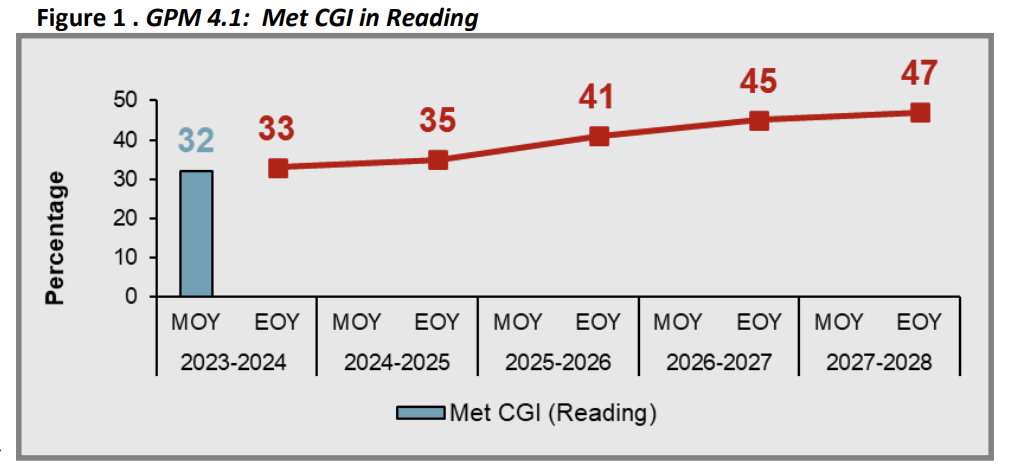
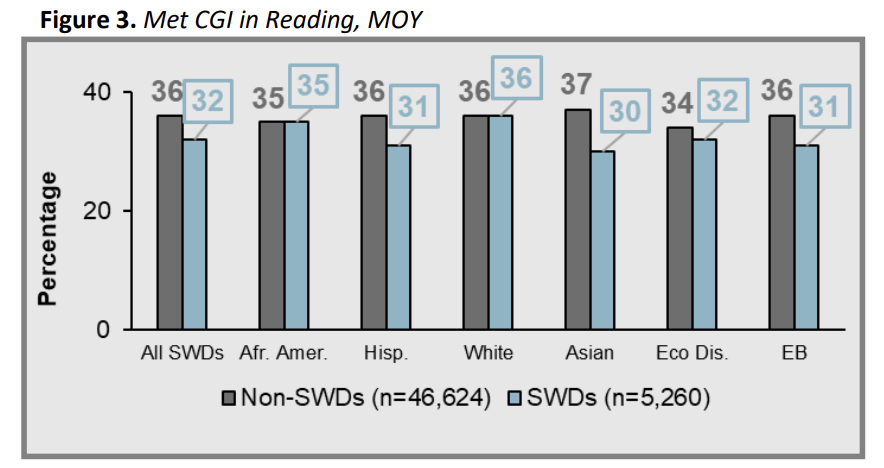
The district is currently on track to meet its end-of-year goal, but it is worth noting that the goal was set based on the middle-of-year baseline because this is the first year the district is using the NWEA MAP assessment.
For Black and white students with disabilities, the percent of students meeting growth targets was on par with students who do not receive special education services. All student groups fell within 7 points of their peers without disabilities. This progress is encouraging, but again, in order to close achievement gaps, the district must sustain higher levels of accelerated growth in special education.
Board Constraint Progress Measure 4.2: The percentage of students in grades 4 through 8 who receive special education services that have a Conditional Growth Index (CGI) of 0.6 or higher on NWEA MAP in Math will increase from 30% in January 2024 to 45% in May 2028.
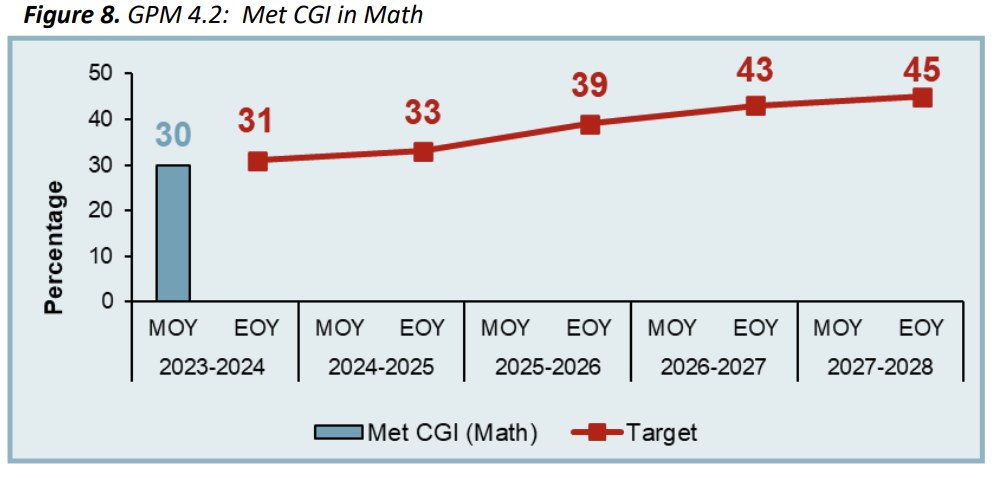
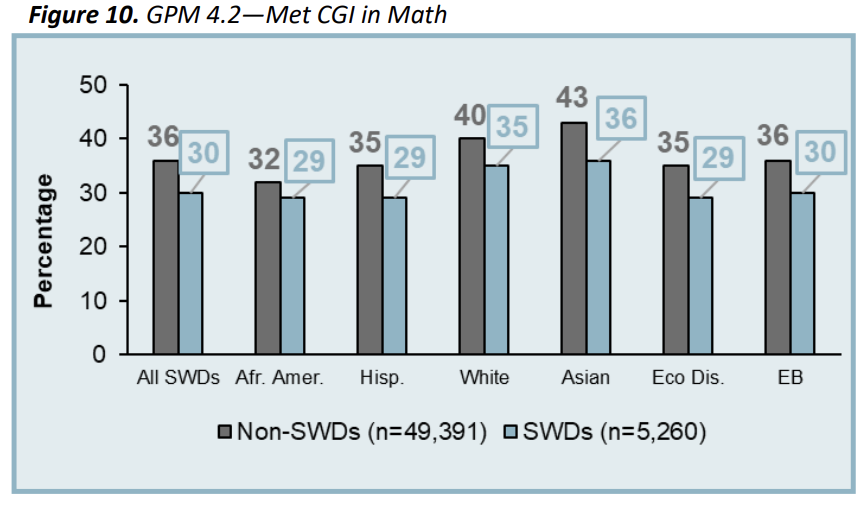
In math, students with disabilities saw slightly higher gaps in percent meeting growth targets compared to their peers without disabilities, but still remained within 7 points. For Black students, they only trailed by 3 percentage points.
The District continues to see higher levels of growth on New Education System (NES) campuses compared to non-NES campuses.
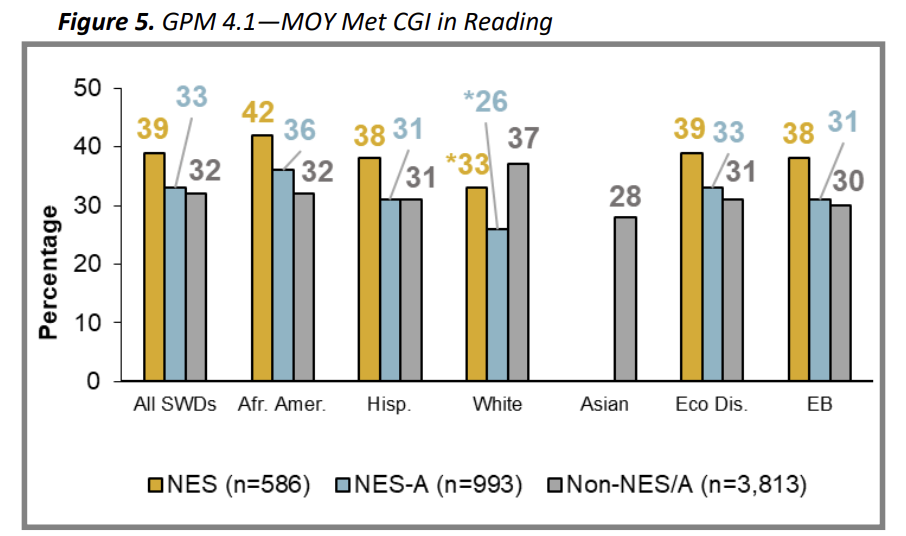
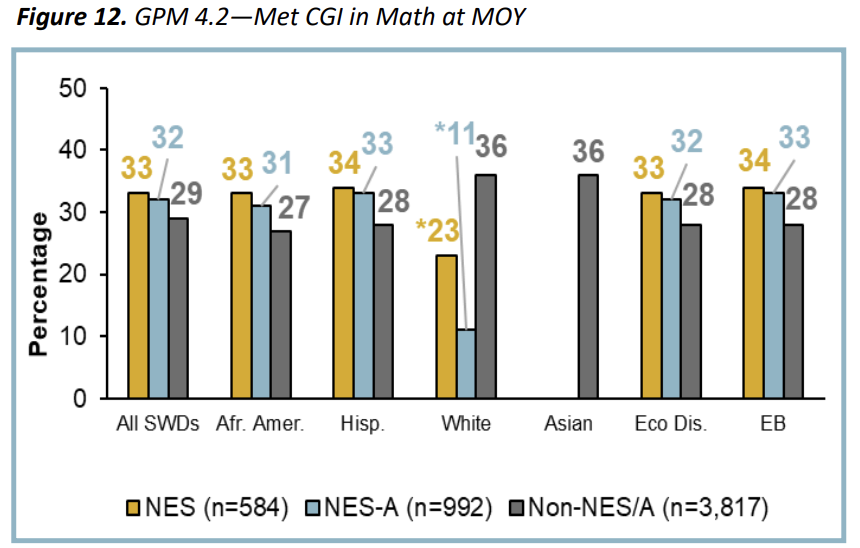
As the district plans to expand the NES model to more campuses next school year, we continue to take a close look at student outcomes on NES campuses. For special education, the District saw a higher percentage of students meeting growth targets at NES campuses compared to non-NES campuses in both reading and math for almost all student groups.
NES campuses were selected to ensure students who have faced historically higher achievement gaps have more targeted support and resources. While this initial set of data from middle-of-year is not a trend, higher growth remains a promising start.
Big Picture: Nearly a third of special education students are meeting above average growth targets by middle-of-year, with higher progress at NES campuses. As the district continues to prioritize special education, it must ensure it continues to maintain and accelerate growth.
BOARD DISCUSSION HIGHLIGHTS
Board members and administration were focused on quality of instruction for special education.
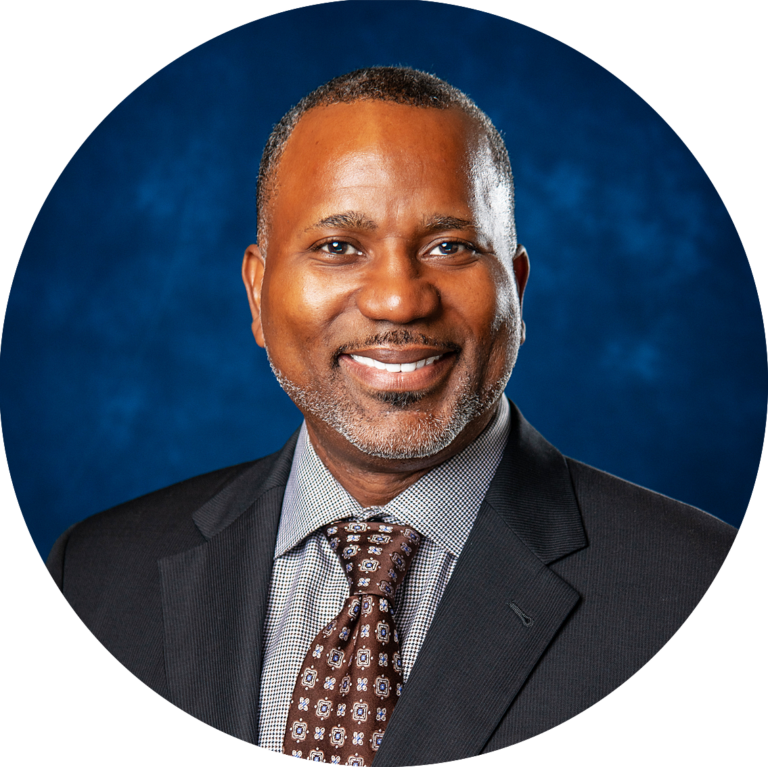

Adam Rivon and Ric Campo: How is the District ensuring quality of instruction that can maintain growth and how do increased teacher salaries support instruction?
Administration Response: Quality of instruction is the root of the growth but it is a continuous improvement process. The District will continue to review data regularly and adjust as needed if they see dips in growth. HISD is also using professional development and division support to ensure instructional quality. Division coordinators and directors are working directly with principals as they conduct spot observations and provide feedback to teachers.
Teachers are the most important component of instruction and special education is a critical shortage area. By increasing salaries for special education teachers, the District can better attract effective educators for students with disabilities.

Janette Garza Lindner: What does the district-wide support plan look like for special education?
Administration Response: The district has trained over 20,000 employees to better identify students in need of special education and have seen an increase in identification. Teams conduct folder reviews of students’ Individualized Education Plans (IEPs) to make sure they are meeting instructional needs.
They are now working on how the IEPs are implemented through coaching conversations with teachers and administrators. Central office is also currently planning professional development for next year based on the information they gathered during the IEP review process.
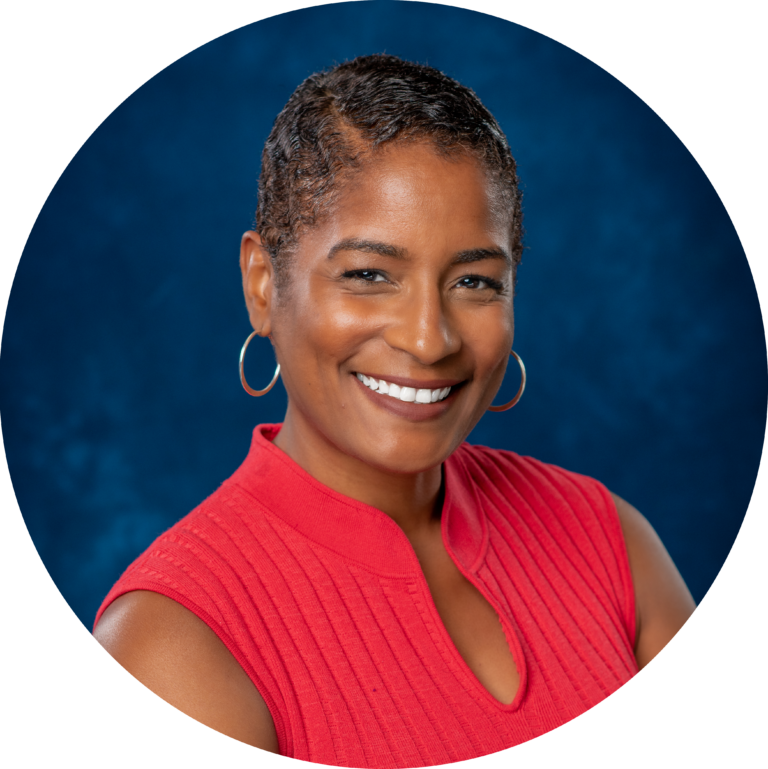
Angela Lemond Flowers: What support is available for principals to help them meet special education requirements? HISD needs to move beyond special education compliance to focus on instruction.
Administration Response: The District is supporting with IEP folder reviews, compliance timeliness, and instructional materials. Every week, division superintendents receive a report from the central office detailing special education data for their campuses. They plan any needed support with their special education unit teams, who sit down with principals for the folder reviews.


Cassandra Auzenne Bandy and Rolando Martinez: What accounts for the differences in growth between NES, NES-aligned (NES-A), and non-NES campuses?
Administration Response: Students at NES and NES-A campuses receive differentiated instruction. In the NES model, students who are further behind receive additional time and direct instruction with teachers, while students who are ahead are able to tackle additional self-guided material.
The original NES schools were targeted because of lower student outcomes, while NES-A campuses joined voluntarily. The District expects to see higher growth at NES campuses because there is more room to grow.
The Board took a closer look at the NES curriculum process as they considered certifying it for the District.

Cassandra Auzenne Bandy: How can we be confident in the NES curriculum without peer review and data?
Administration Response: The District has a process for the NES curriculum that starts with ensuring all state standards are covered. They map each day of the year to the full set of standards and then look at planning for individual standards. The District uses state-approved materials as the building blocks for the differentiated NES curriculum, which is a product that is not currently available on the market. Teams of people review the materials before they are sent to campuses and teachers are able to provide feedback. It is worth noting that TEA also does not take into account peer review in their process and the HISD curriculum team received training by TEA approved providers.

Michelle Cruz Arnold: Should the district pursue a review through the state’s process or through Region 4?
Administration Response: The state is currently building a new process for reviewing high-quality instructional materials and HISD wants to make sure it stays aligned to the state’s standard. They would discourage a review through a provider other than the state.
Previously, the state did not review district-created materials. If they were to seek state review, it would reduce the flexibility the district has to alter materials based on feedback.
Time Check: This month, the Board spent around 46% of their meeting time focused on student outcome monitoring, excluding time spent hearing from community speakers. This is the first time in recent months that the board has dipped below 50% of their time focused on student outcomes. We appreciated the curriculum-focused discussion and understand that there are times when the board may have to dig deeper into non-student focused items. However, we encourage the board to reassess how they prioritize their meetings moving forward to maintain their commitment to student outcomes.
Why this Matters: High-performing school Districts have school boards that spend most of their time focused on student outcomes rather than operations. Lone Star Governance recommends boards spend at least 50% of their time engaged in student outcome monitoring.
OTHER MEETING HIGHLIGHTS
The Board approved the NES curriculum state certification.
Each year, if the district is using locally developed curricula, it is statutorily required to certify that it is covering 100% of the state educational standards, the Texas Essential Knowledge and Skills (TEKS). The Board engaged in a thoughtful discussion about the NES curriculum (some of which is highlighted above) before voting to certify.
The Board will move forward with their community engagement plan.
The Board has been actively working on their community engagement plan. The drafted plan includes community meetings in the fall and spring of each year for two-way communication on student outcome monitoring and district governance. These meetings will be hosted by at least two members of the board and will be scripted to ensure every area of the community receives the same information. This process will kick off later this month with a meeting focused exclusively on receiving student feedback.
